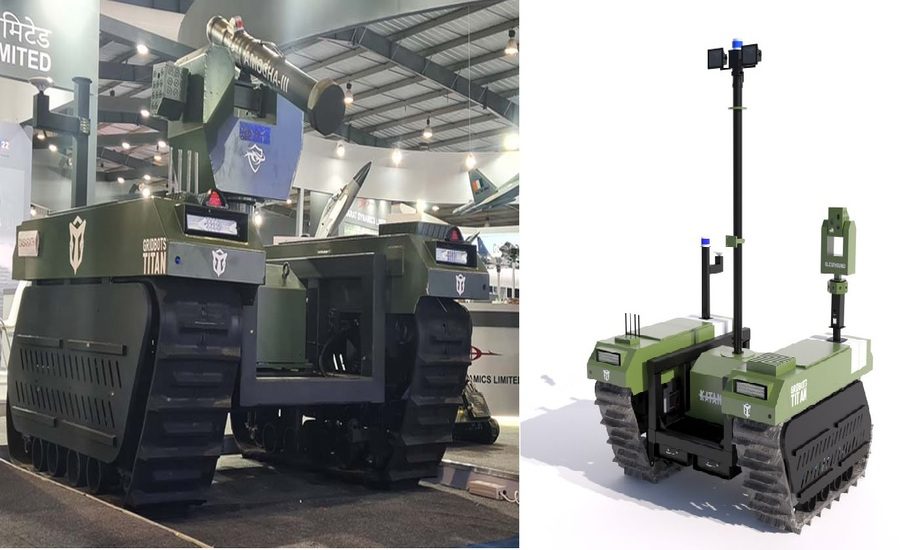Gujarat: India’s defence sector has taken a bold leap forward as Ahmedabad-based Gridbots Technologies Pvt. Ltd. unveiled the Titan Fortifier, billed as the world’s first fully autonomous anti-tank minelaying robot.
This innovation signals a shift from traditional manual mine-laying operations to automated, AI-driven battlefield engineering—strengthening India’s drive for indigenous defence capabilities and robotics.
Background of Titan Fortifier
Mine deployment has long been a critical component of terrain denial and border defence.
Read Also: Indian Navy Signs ₹66 Crore Deal with Odisha-Based Startup for Indigenous Underwater Robots
Engineers manually emplace anti-tank mines under hazardous conditions—exposing troops to risk. The Indian defence robotics ecosystem, motivated by the need for force-multipliers and safer operational modes, has led to the development of unmanned ground vehicles (UGVs). Gridbots’ Titan series is part of this trend.
With the Titan Fortifier, the company builds on its earlier Titan platform (used for multi-utility ground robotics) to deliver a dedicated minelaying capability.
What the Titan Fortifier Brings to the Table
- The robot can carry up to 50 anti-tank “brick mines” weighing collectively ~600 kg.
- It can deploy these mines autonomously along a route over 50 km on a single charge—a significant endurance in field conditions.
- Navigation and deployment features include hybrid visual + 3D LiDAR-based SLAM for obstacle avoidance, route planning across all-terrain (plains, deserts, high altitude) and GPS-denied environments.
- Communication uses encrypted 5.8 GHz mesh radio links, enabling real-time secure command and control of networked units.
- The chassis is built on the Titan combat vehicle framework—chromium steel, IP65 sealed for all-weather operation, hot-swappable LiFePO4 power packs, and runtime of ~12 hours.
- Mapping accuracy of ~20 mm and docking accuracy ~15 mm in terrain mapping and autonomous operations.
Importance & Implications of Titan Fortifier
- Force multiplier for combat engineering and border defence: The Titan Fortifier reduces the exposure of troops during minefield emplacement in contested zones—meaning safer, faster mine deployment in high-threat regions.
- Indigenisation and strategic autonomy: By enabling such advanced robotics domestically, India strengthens its defence-manufacturing base and reduces dependence on foreign imports—a key strategic goal under the “Make in India” and Atmanirbhar Bharat defence initiatives.
- Technology leap in battlefield automation: Autonomous robotics in land warfare has been largely limited to mine-clearing or remote control roles globally. Fully autonomous mine-laying systems are rare; Gridbots’ announcement places India among a handful of nations exploring this domain.
- Operational flexibility: Such a system allows for rapid terrain denial, strategic fortification, autonomous operations in GPS-denied zones (important in mountainous or forested border regions), and networked multi-unit deployment patterns.
Key Challenges to Watch
- Legal & ethical complexities: Mine deployment remains sensitive under international law, especially given the humanitarian risk of unexploded ordnance. While anti-tank mines per se are permitted, autonomous systems raise questions of control, accountability and safety.
- Technical robustness & field readiness; Even with laboratory performance numbers, real-world terrain, weather, electronic warfare, and ruggedness pose major tests. Ensuring reliability across Indian border terrain (Himalayas, deserts, coastal marshes) will be critical.
- Integration with existing forces and tactics: Deploying autonomous systems within army formations means retraining, new doctrines, secure mission-planning, C2 integration, and cybersecurity hardening. The interplay between human engineers and autonomous UGVs will need doctrinal clarity.
- Cost & scale of deployment: Prototype launch is one thing; mass fielding, logistics, maintenance, spares, mission-support and lifecycle costs will pose budgeting and planning challenges.
Way Forward
- Testing & validation: Deployment of Titan Fortifier in limited numbers under the Indian Army’s Combat Engineers Directorate will provide vital field-data and feedback.
- Doctrine and training: The Indian Army must evolve doctrine for autonomous engineering systems, create training modules for operators and commanders, and integrate UGVs into combined arms tactics.
- Safety and certification: Establish protocols for mine deployment safety, incorporate self-neutralising or self-deactivating mine mechanisms (as mentioned for compliance) and review legal frameworks.
- Mass manufacture & supply-chain: Leverage India’s defence-industrial base to scale production, ensure supply of critical components (e.g., Nvidia GPUs, LiDAR modules, power packs) and maintain indigenous capacity.
- Scaling across terrains and missions: Beyond mine laying, Gridbots’ Titan platform modularity suggests future variants (mine-sweeper, logistics, surveillance). The way ahead involves adaptation to multi-role tasks and interoperable battlefield systems.



























